Industrial Insulators Market Size and Trends
The global industrial insulation market is estimated to be valued at USD 4.51 Bn in 2025 and is expected to reach USD 6.39 Bn by 2032, growing at a compound annual growth rate (CAGR) of 5.1% from 2025 to 2032.
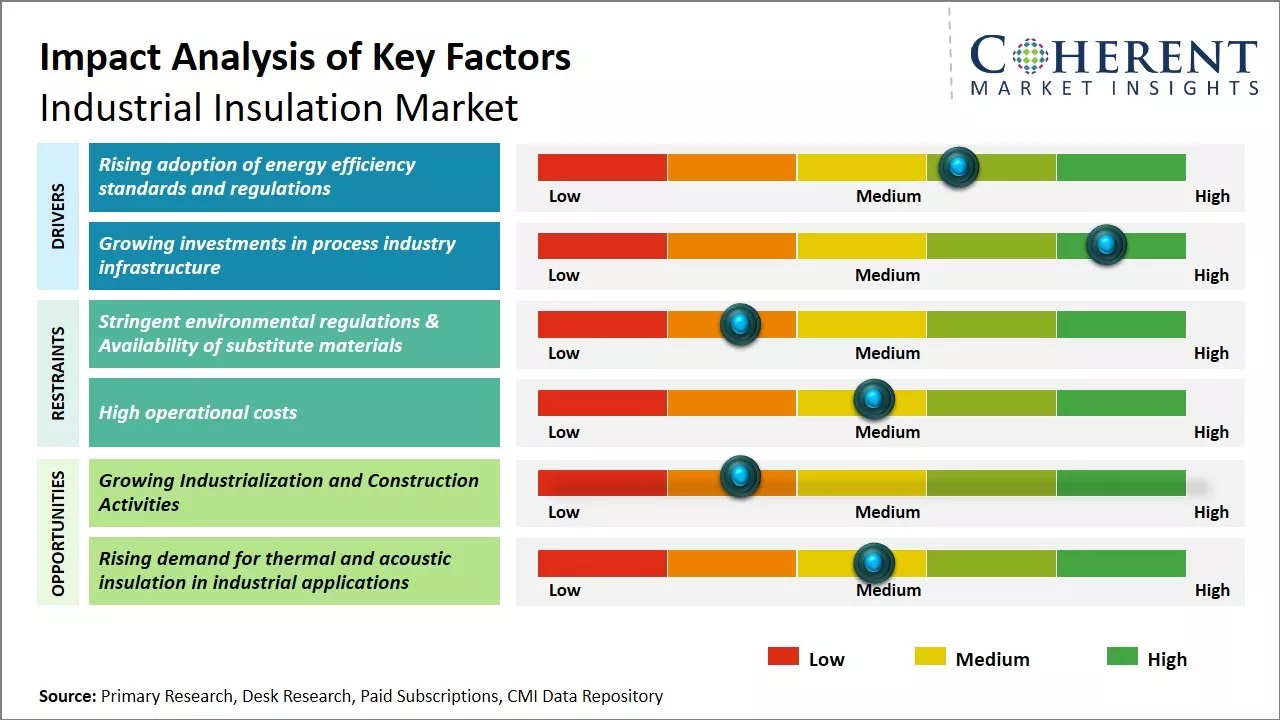
Discover market dynamics shaping the industry: Download Free Sample
The industrial insulation market is expected to witness significant growth over the forecast period. Rising energy costs across major industries, such as petrochemicals, oil & gas, power generation, and cement, is encouraging end users to focus on energy efficiency through the optimum utilization of insulation systems. Furthermore, stringent government regulations regarding energy efficiency and greenhouse gas emissions from industrial facilities is further promoting the utilization of insulation systems. Manufacturers are hence increasingly developing innovative, sustainable, and cost-effective insulation solutions to cater to the growing demand. Significant investments by major economies in the expansion of their oil & gas and petrochemical industries will also drive the consumption of insulation materials in the coming years.
Rising adoption of energy efficiency standards and regulations
With growing environmental concerns and increasing focus on reducing carbon emissions, many countries and organizations have implemented stringent regulations mandating higher levels of energy efficiency in industrial facilities and operations. Industrial insulation plays a crucial role in improving energy efficiency by reducing heat transfer and thermal bridging. It helps lower energy costs significantly by minimizing energy losses. Various governments around the world have passed legislations that industrial and commercial facilities must meet certain insulation standards to minimize heat gain and loss. For instance, according to the data published on December 7, 2023, the EU Energy Performance of Buildings Directive (EPBD) sets minimum energy performance requirements for new and existing buildings including industrial and commercial facilities. According to the same source, Each Member State would adopt its own national trajectory to reduce the average primary energy use of residential buildings by 1 6.39 % by 2030 and 20-22% by 2035. This is driving greater demand for advanced insulation materials that can help organizations comply with the new energy efficiency protocols. Major industries like oil & gas, petrochemical, power, and manufacturing have to abide by these regulations and optimize insulation levels, thereby promoting the increased adoption of high-performance insulation systems. The enforcement of stricter policies to curb greenhouse gas emissions and fossil fuel usage is expected to continue supporting the industrial insulation market growth.
Market Concentration and Competitive Landscape
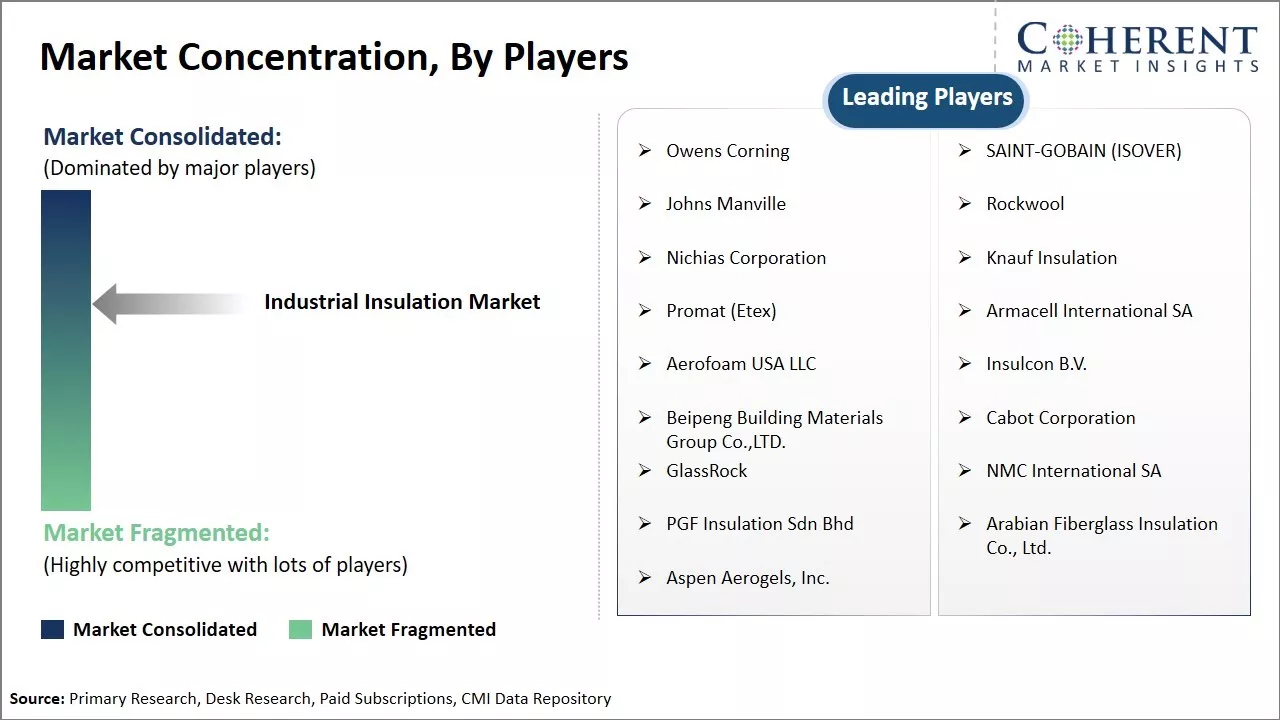
Get actionable strategies to beat competition: Download Free Sample
Growing investments in process industry infrastructureRising industrial activities have fuelled significant investments in new plants, machinery, and infrastructure expansion activities across major process industries. The oil and gas, petrochemical, power, mining, and other core sectors are spending heavily on setting up new production facilities to meet the burgeoning demand. At the same time, existing manufacturing setups also require the revamping and upgrading of their facilities at regular intervals. All such new construction and renovation projects involve extensive installation of insulation systems for thermal management, corrosion protection, personnel safety as well as compliance with energy codes. Growing investments in expanding production capacities and building new process plants augur well for sustained demand for industrial insulation from the infrastructure perspective. For instance, according to data published by the International Energy Agency report on July 11, 2023, the operations of buildings account for 30% of the global final energy consumption and 26% of the global energy-related emissions (8% being direct emissions in buildings and 18% indirect emissions from the production of electricity and heat used in buildings). Prominent industry players are also continuously carrying out major capital expenditure towards insulation retrofitting and recoating works at their operational sites leading to recurring sales opportunities.
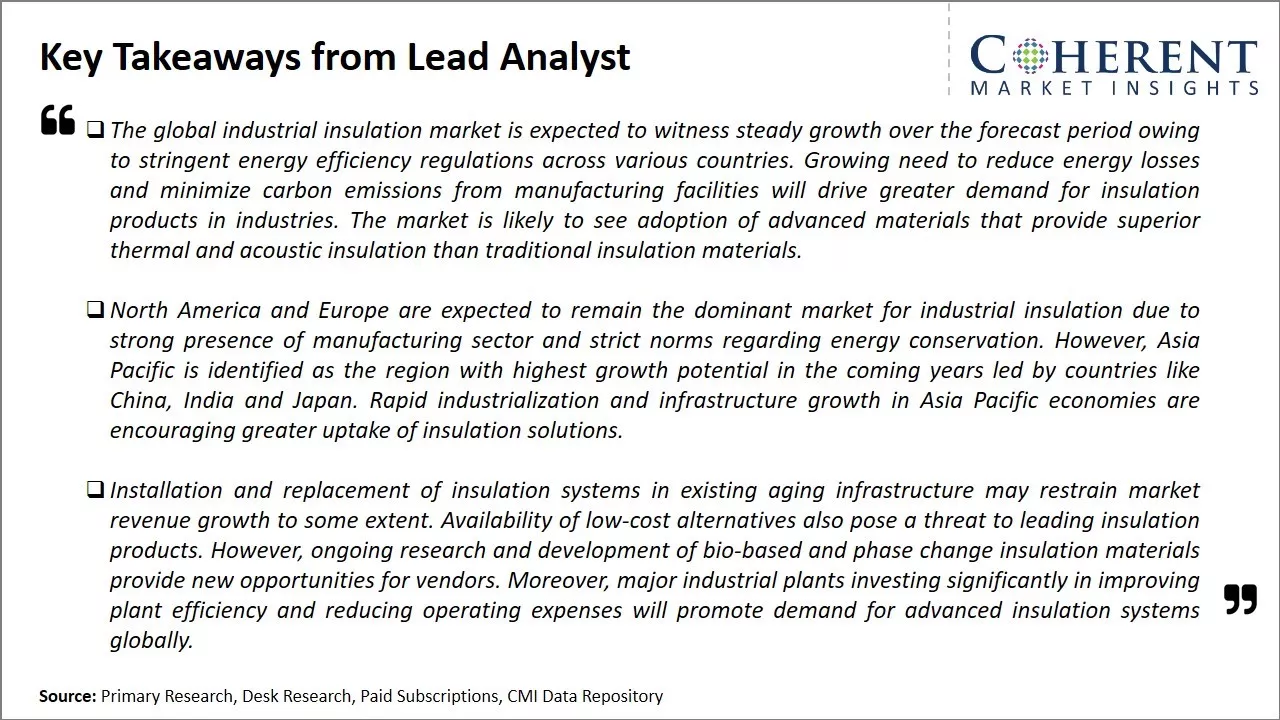
To learn more about this report, Download Free Sample
Market Challenges: Stringent environmental regulations & Availability of substitute materialsThe global industrial insulation market faces several challenges. Stringent environmental regulations globally are increasing costs of compliance for insulation materials. Also, developing nations have lower acceptance and enforcement of such regulations currently. Availability of substitute materials offering similar functionality at lower costs also poses a threat. Maintaining quality standards and focusing on new areas of insulation needs will be the key to sustain growth.
Market Opportunities: Growing Industrialization and Construction Activities
The market sees significant opportunities too. Growing industrialization and construction activities in emerging economies will boost demand. Also, increasing focus on energy efficiency is raising the usage of insulation in process industry equipment and facilities. Substitution of aging infrastructure in developed nations necessitates insulation upgrades. Developing innovative materials catering to customized project needs would open up new revenue streams.
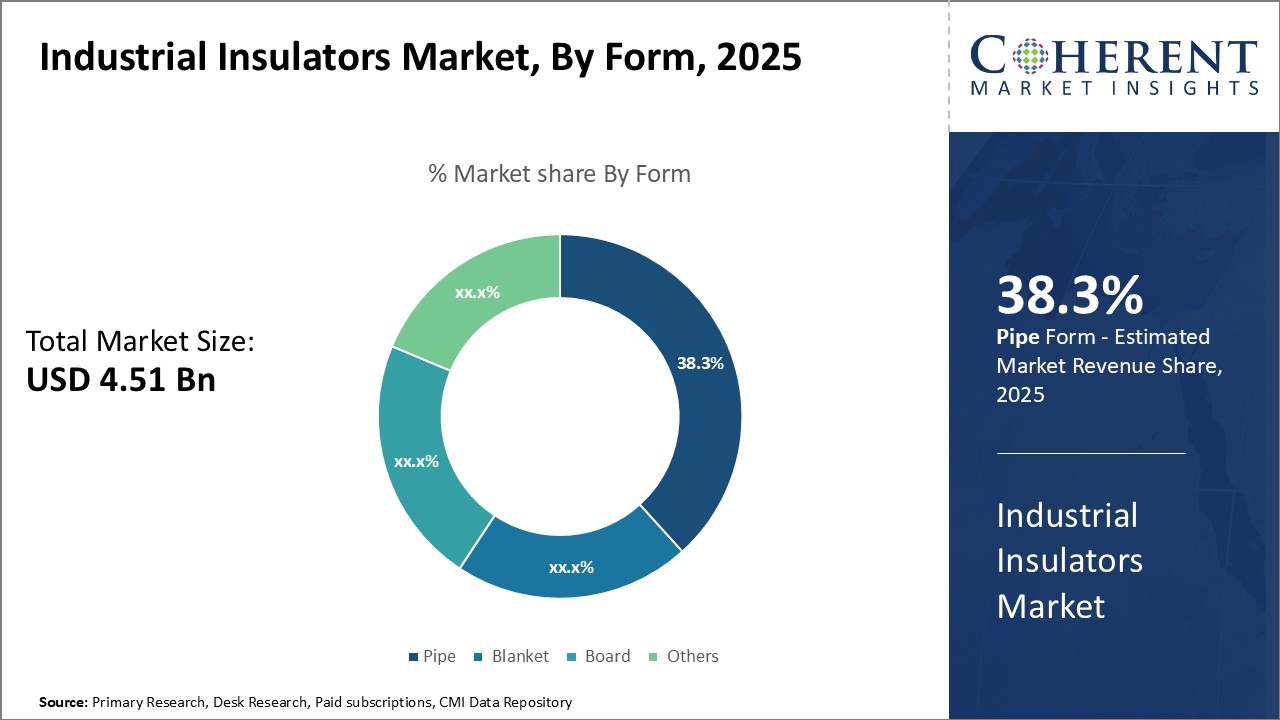
Discover high revenue pocket segments and roadmap to it: Download Free Sample
Insights, By Form: Durable construction drives the dominance of pipe insulationIn terms of form, the pipe segment contributes 38.3% share of the global industrial insulation market owing to its durable construction and versatility. Pipe insulation provides critical protection for various piping infrastructure used across industries. Pipes frequently carry high temperature fluids and gases, requiring robust insulation to prevent heat transfer. Compared to other forms, pipe insulation can withstand frequent vibration and movement within complex piping systems. It is designed to remain securely attached to piping surfaces without degradation over long usage periods. Various cladding and wrapping techniques provide pipe insulation superior resistance to moisture, chemicals, and other environmental factors.
Insights, By Material: Mineral wool thermally outperforms with cost benefits
In terms of material, mineral wool accounts for 37% share of the global industrial insulation market owing to its excellent thermal insulation capabilities and cost-effectiveness. Mineral wool is created by spinning or blowing slag or rock and clay into fine fibers. It performs well as an insulation material due to its highly porous, fibrous structure trapping small pockets of air. This achieves superior thermal resistance with low density and heat transfer properties comparable to rigid foam insulations. Additionally, mineral wool offers cost benefits over alternatives. It exhibits durability through resistance to corrosion, rotting, decay and vermin/pest damage. This longevity lowers total costs of ownership in comparison to plastic foams with shorter replacement intervals. Mineral wool production also utilizes abundant, affordable raw material inputs versus expensive petroleum feedstock for plastic foams. Overall thermal performance combined with lowest total cost of ownership drive mineral wool's widespread use in industrial insulation applications.
Insights, By Application: Refining and petrochemical sector heat mitigation needs
In terms of application, the petrochemical and refineries segment contribute 38.7% share in the global industrial insulation market due to their extensive heat mitigation requirements. Petrochemical and oil refining activities involve numerous exothermic cracking, reforming, and chemical reactions producing large amounts of waste heat. High process temperatures, occasionally exceeding 600°C, are also common across units from distillation columns to reactors and furnaces. Effective insulation is therefore vital across refineries and petrochemical plants to regulate internal equipment temperatures, prevent heat losses and protect personnel. Specific units like fractionators, heat exchangers, and pipes transporting high heat fluids face greatest insulation needs. Energy savings from reducing heat transfer translate directly into substantial cost savings for these capital-intensive industries focused on optimization.
Regional Insights
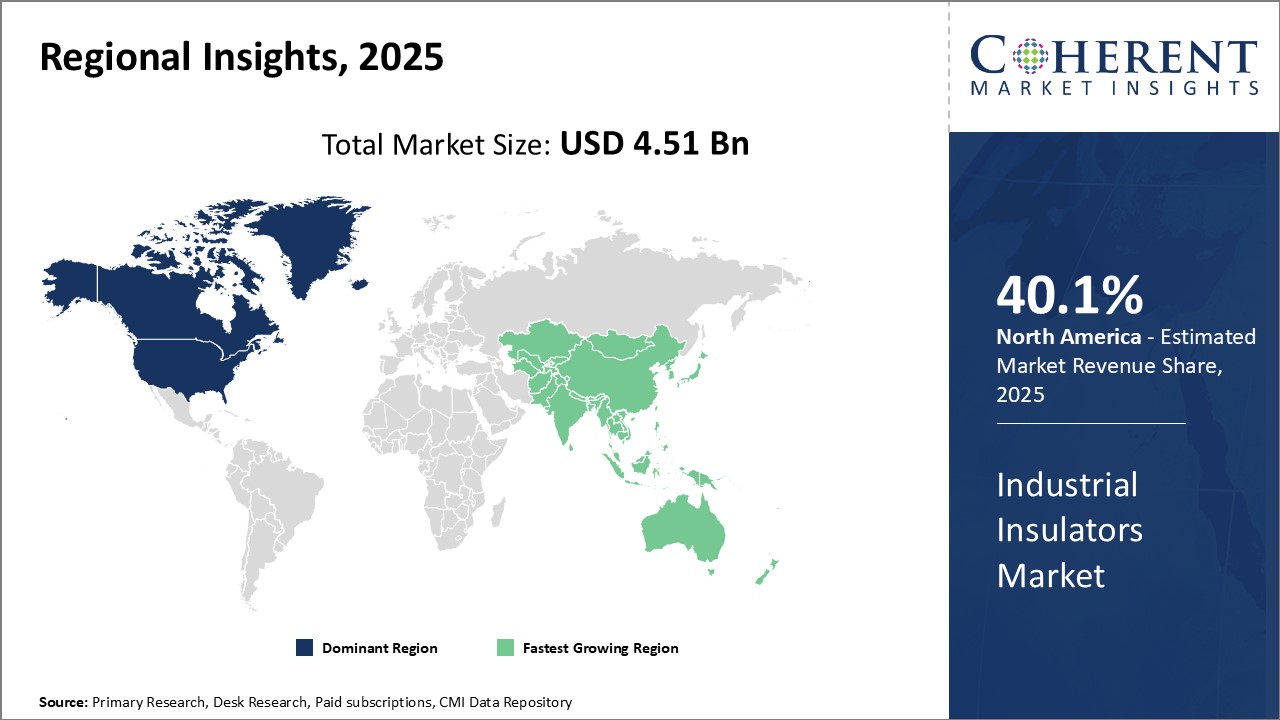
Need a Different Region or Segment? Download Free Sample
North America currently dominates the global industrial insulation market along with 40.1% market share. This can be attributed to the region's strong presence of manufacturing industries across sectors such as oil & gas, power generation, cement, and chemicals. The region is home to some of the largest players in these industries such as ExxonMobil, Dow Chemical, and General Electric. This well-established industrial base demands significant volumes of insulation materials to achieve operational efficiency by regulating temperature in equipment and piping lines.
Another important factor for North America's dominance is its well-defined regulatory environment pertaining to energy conservation. Strict guidelines around emissions norms and energy efficiency standards have compelled industrial players in the region to invest heavily in insulation solutions. Replacing and upgrading aging insulation infrastructure also contributes additional demand. Given the scale and purchasing power of players in the regional industries, key insulation suppliers achieve significant market penetration. They are also able to sustain competitive pricing for product offerings here compared to other regions.
The Asia Pacific region has emerged as the fastest growing market for industrial insulation. This growth can be primarily attributed to the massive industrial expansion underway in countries like China and India. Both nations are witnessing aggressive capacity additions across major energy-intensive industries such as power, iron & steel and cement to cater to rising domestic demand as economies develop. Given the developing status of these industries, much of the new capacity addition demands complete insulation solutions during construction. This insulates Asia Pacific from the risks of saturation facing mature markets.
Market Report Scope
Industrial Insulators Market Report Coverage
| Report Coverage | Details | ||
|---|---|---|---|
| Base Year: | 2024 | Market Size in 2025: | USD 4.51 Bn |
| Historical Data for: | 2020 To 2024 | Forecast Period: | 2025 To 2032 |
| Forecast Period 2025 to 2032 CAGR: | 5.1% | 2032 Value Projection: | USD 6.39 Bn |
| Geographies covered: |
|
||
| Segments covered: |
|
||
| Companies covered: |
Owens Corning, SAINT-GOBAIN (ISOVER), Johns Manville, Rockwool, Nichias Corporation, Knauf Insulation, Promat (Etex), Armacell International SA, Aerofoam USA LLC, Insulcon B.V., Beipeng Building Materials Group Co.,LTD., Cabot Corporation, GlassRock, NMC International SA, PGF Insulation Sdn Bhd, Arabian Fiberglass Insulation Co., Ltd., Aspen Aerogels, Inc. |
||
| Growth Drivers: |
|
||
| Restraints & Challenges: |
|
||
Uncover macros and micros vetted on 75+ parameters: Get instant access to report
Market Segmentation
- Form Insights (Revenue, USD Bn & KT, 2020 - 2032)
- Pipe
- Blanket
- Board
- Others
- Material Insights (Revenue, USD Bn & KT, 2020 - 2032)
- Mineral Wool
- Calcium Silicate
- Others (Plastic Foams, etc.)
- Application Insights (Revenue, USD Bn & KT, 2020 - 2032)
- Power Generation
- Petrochemical & Refineries
- EIP Industries
- LNG/LPG
- Others
- Regional Insights (Revenue, USD Bn & KT, 2020 - 2032)
- North America
- U.S.
- Canada
- Latin America
- Brazil
- Argentina
- Mexico
- Rest of Latin America
- Europe
- Germany
- U.K.
- Spain
- France
- Italy
- Russia
- Rest of Europe
- Asia Pacific
- China
- India
- Japan
- Australia
- South Korea
- ASEAN
- Rest of Asia Pacific
- Middle East & Africa
- GCC Countries
- Israel
- Rest of Middle East & Africa
- North America
- Key Players Insights
- Owens Corning
- SAINT-GOBAIN (ISOVER)
- Johns Manville
- Rockwool
- Nichias Corporation
- Knauf Insulation
- Promat (Etex)
- Armacell International SA
- Aerofoam USA LLC
- Insulcon B.V.
- Beipeng Building Materials Group Co.,LTD.
- Cabot Corporation
- GlassRock
- NMC International SA
- PGF Insulation Sdn Bhd
Share
Share
Missing comfort of reading report in your local language? Find your preferred language :
Transform your Strategy with Exclusive Trending Reports :
Frequently Asked Questions
EXISTING CLIENTELE
Joining thousands of companies around the world committed to making the Excellent Business Solutions.
View All Our Clients
